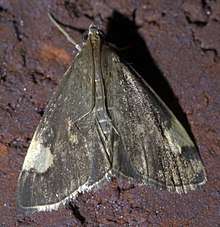Evergestis unimacula
| Evergestis unimacula | |
|---|---|
 | |
| Scientific classification | |
| Kingdom: | Animalia |
| Phylum: | Arthropoda |
| Class: | Insecta |
| Order: | Lepidoptera |
| Family: | Crambidae |
| Genus: | Evergestis |
| Species: | E. unimacula |
| Binomial name | |
| Evergestis unimacula | |
| Synonyms | |
| |
Evergestis unimacula, the large-spotted evergestis moth, is a moth in the Crambidae family. It was described by Augustus Radcliffe Grote and Coleman Townsend Robinson in 1867.[1] It is found in North America, where it has been recorded from Georgia, Illinois, Indiana, Iowa, Maryland, Michigan, North Carolina, Ohio, Oklahoma, Ontario, Pennsylvania, Quebec, Tennessee and West Virginia.[2] Outliers have been recorded from Florida.
The wingspan is 18–22 mm. The forewings are dark grayish brown with a pale patch along the outer half of the costa, as well as a small pale discal spot in the lower half of the wing and a dark terminal line. The hindwings are similar in color, but have a more diffuse pale patch. Adults are on wing from May to August.
Etymology
The species name is derived from Latin unimacula (meaning one spot).[3]
References
- ↑ Nuss, M.; et al. (2003–2017). "GlobIZ search". Global Information System on Pyraloidea. Retrieved June 28, 2018.
- ↑ "801075.00 – 4901 – Evergestis unimacula – Large-spotted Evergestis Moth – (Grote & Robinson, 1867)". North American Moth Photographers Group. Mississippi State University. Retrieved June 28, 2018.
- ↑ McLeod, Robin (August 3, 2014). "Species Evergestis unimacula - Large-spotted Evergestis - Hodges#4901". BugGuide. Retrieved June 28, 2018.